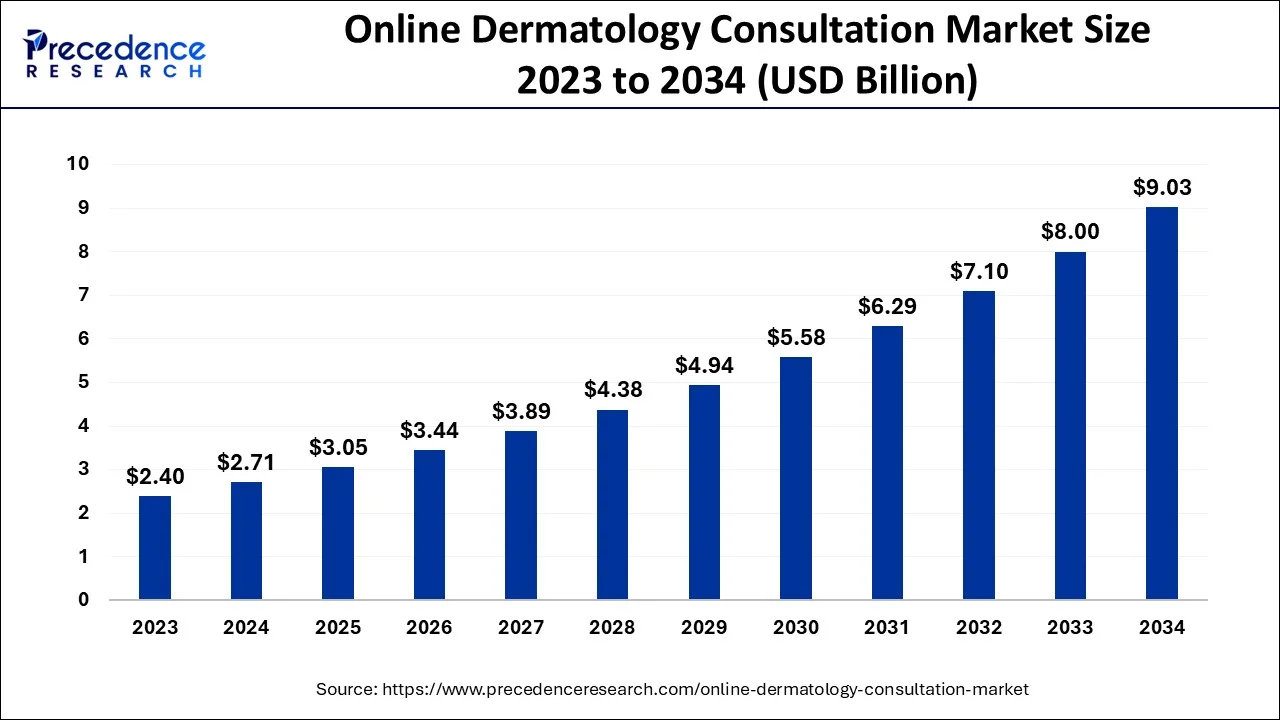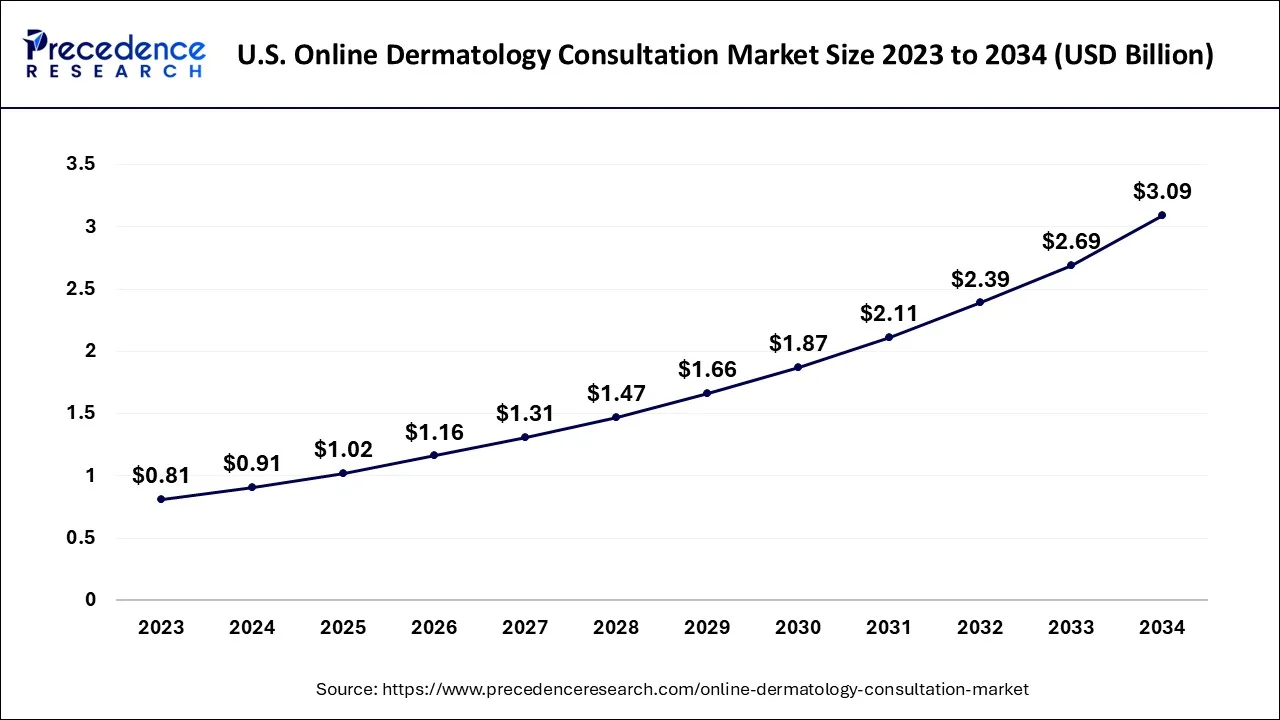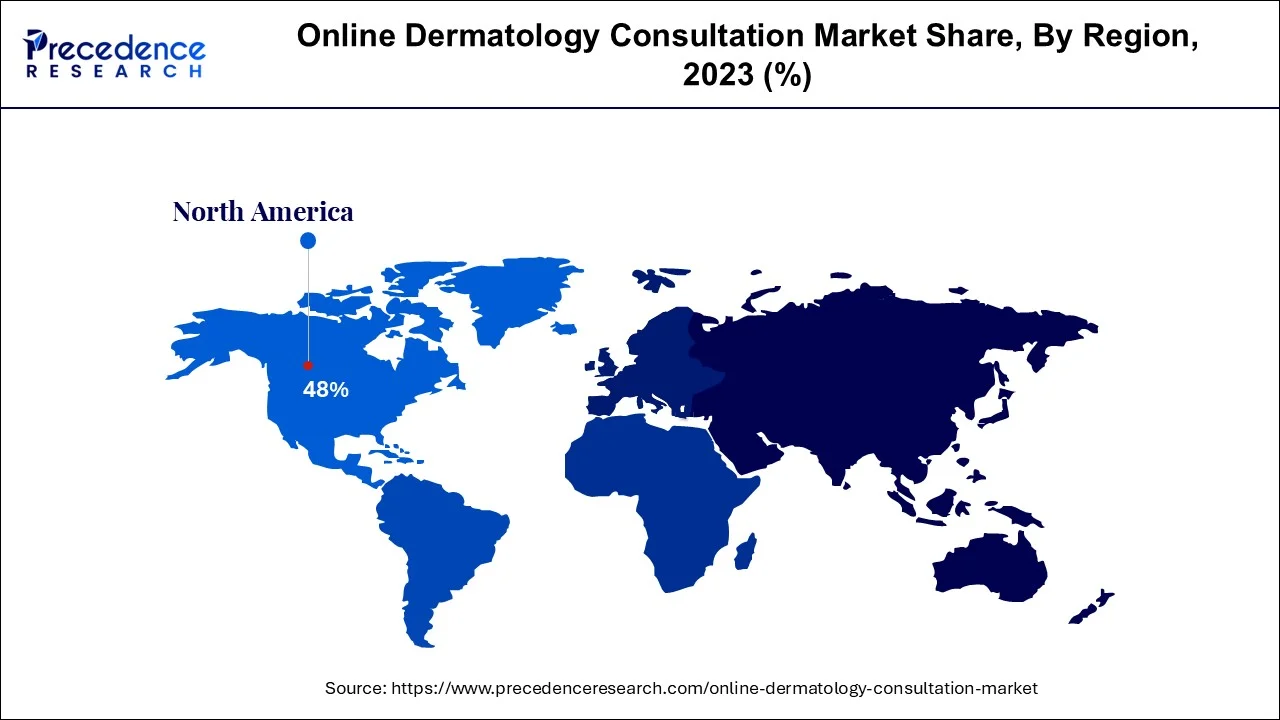November 2024
The global online dermatology consultation market size is estimated at USD 2.71 billion in 2024, grew to USD 3.05 billion in 2025 and is predicted to surpass around USD 9.03 billion by 2034, expanding at a CAGR of 12.80% between 2024 and 2034. The North America online dermatology consultation market size accounted for USD 1.30 billion in 2024 and is anticipated to grow at a fastest CAGR of 12.91% during the forecast year.
The global online dermatology consultation market size accounted for USD 2.71 billion in 2024 and is anticipated to reach around USD 9.03 billion by 2034, expanding at a CAGR of 12.80% between 2024 and 2034. A branch of dermatology known as online dermatology consultation uses digital medical information interchange and telecommunication technology to monitor, diagnose, and treat skin disorders like eczema, psoriasis, melanoma, and others.

The U.S. online dermatology consultation market size is estomated at USD 0.91 billion in 2024 and is predicted to be worth around USD 3.09 billion by 2034, growing at a CAGR of 12.99% between 2024 and 2034.

With more than $1.5 billion in sales in 2023, North America is expected to continue to dominate the worldwide market during the forecast period. The quick adoption and use of online platforms by several healthcare facilities will stimulate market expansion across Canada and the US. Additionally, a strong U.S. government along with an increase in significant companies like MDlive and DermatologistOnCall are anticipated to drive the North American market throughout the projection period. Europe is anticipated to be the second-largest area and will likely make up a sizeable portion of the worldwide market. Due to the increased use of newer technologies and improved teledermatology services, high-growth nations like Germany, the UK, Italy, and France would contribute to the market growth in Europe, which is predicted to result in a higher rate of market growth in the area.

In terms of the size of the worldwide market, Asia Pacific is anticipated to exhibit significant development opportunities throughout the forecast period. The market is anticipated to increase as a result of factors including the existence of a supportive government policy for telemedicine services and the rising demand for online dermatology consultation in important nations like China and India.
Due to the restricted availability of teledermatology equipment in developing nations in Africa and the less favorable reimbursement prospects, the Middle East and Africa would increase at a significantly slower rate. To expand access to dermatological treatment for the bulk of the patient population, teledermatology is supported by a growing number of dermatologists in the area. As a result, during the course of the forecast, the region is likely to have growth opportunities.
As more schools, like Boston University, started offering online platforms for education and remote consulting, these trends have given the sector a boost. Worldwide, a number of commercial health consultant firms are also playing significant roles in the provision of diagnosis services. The main drivers of growth for the global online dermatological consultation market are the advantages and widespread use of online dermatological consultation. One of the main driving forces behind the adoption of investments and online dermatology consultation services in the telemedicine sector is government measures to reduce healthcare costs and expand specialist health care.
The expansion of the worldwide teledermatology market will be greatly assisted by improvements in the IT and telecommunications sectors. The main factors anticipated to drive the global market are the rising investment in R&D programs for the development of many preventative teledermatology and recommendations offered by regulatory organizations related to online education and remote consultation. The development of technologically advanced healthcare infrastructure and ongoing research projects in collaboration with renowned vendors and international universities for the development of efficient teledermatology will present the global market with lucrative growth opportunities.
To increase their commercial reach and profitability, the major market players concentrate on forging strategic alliances and purchasing allying companies. Additionally, the main market players are able to expand their product portfolios due to the increased acceptance of technology developments in the healthcare industry. Additionally, cutting-edge product development techniques enable major market participants to provide new items and satisfy consumer demand. For instance, Teladoc Health Inc. and Microsoft worked together to integrate hospitals and health systems into the Microsoft Teams environment in 2021. Due to increased consumer desire and improved physician and patient access to virtual healthcare, this relationship has made it possible for the firm to grow its offering.
| Report Coverage | Details |
| Market Size in 2024 | USD 2.71 Billion |
| Market Size by 2034 | USD 9.03 Billion |
| Growth Rate from 2024 to 2034 | CAGR of 12.8% |
| Largest Market | North America |
| Fastest Growing Market | Asia Pacific |
| Base Year | 2023 |
| Forecast Period | 2024 to 2034 |
| Segments Covered |
|
| Regions Covered |
|
Rising shortage of dermatologist per million population
The surge in incidence of dermatological conditions
The decline in the usage of telemedicine among physicians post-pandemic
Incorporation of artificial intelligence
The market is divided into asynchronous (store and forward), synchronous (real-time), and other segments based on modality. The store and the forward segment have captured a market revenue share of 70.90% in 2023. Due to the widespread use of virtual consultations as a modality for online dermatological consultations in 2021, the store and the forward sector had the lion's share of the market. Due to the high demand for dermatological pictures for the precise evaluation of illnesses, the industry is primarily dependent on the store and forward modality.
The strong use of this method to make up for the shortage of dermatologists might increase the global market share. Due to the technical superiority of this modality compared to other types, the real-time category, which represented the second biggest share of the online dermatologist market in 2021, is anticipated to develop at the greatest CAGR throughout the projected period.
The global market is divided into healthcare facilities and home care based on the end user. Due to an increase in patients seeking online dermatology consultations from the comfort of their homes, the homecare sector is anticipated to earn the largest revenues in the worldwide market over the forecast period. Additionally, since they reduce the need for hospital trips, the elderly population's increased use of teleconsultation and the capacity to correctly monitor them remotely in home care settings are some of the causes responsible for the segment's rise. The expanded availability of initiatives by industry participants, such as online dermatological consultation programs, in important regional markets like the United States is projected to drive the segment's market expansion.
As hospitals focus on implementing online dermatology consultation for the management of its hospital dermatology referrals and introduce a larger patient populace for effective dermatological care, healthcare facilities are also anticipated to enjoy significant growth throughout the forecast period.
Segment Covered in the Report
By Modality
By End User
By Geography
For inquiries regarding discounts, bulk purchases, or customization requests, please contact us at sales@precedenceresearch.com
No cookie-cutter, only authentic analysis – take the 1st step to become a Precedence Research client
November 2024
November 2024
December 2024
August 2024